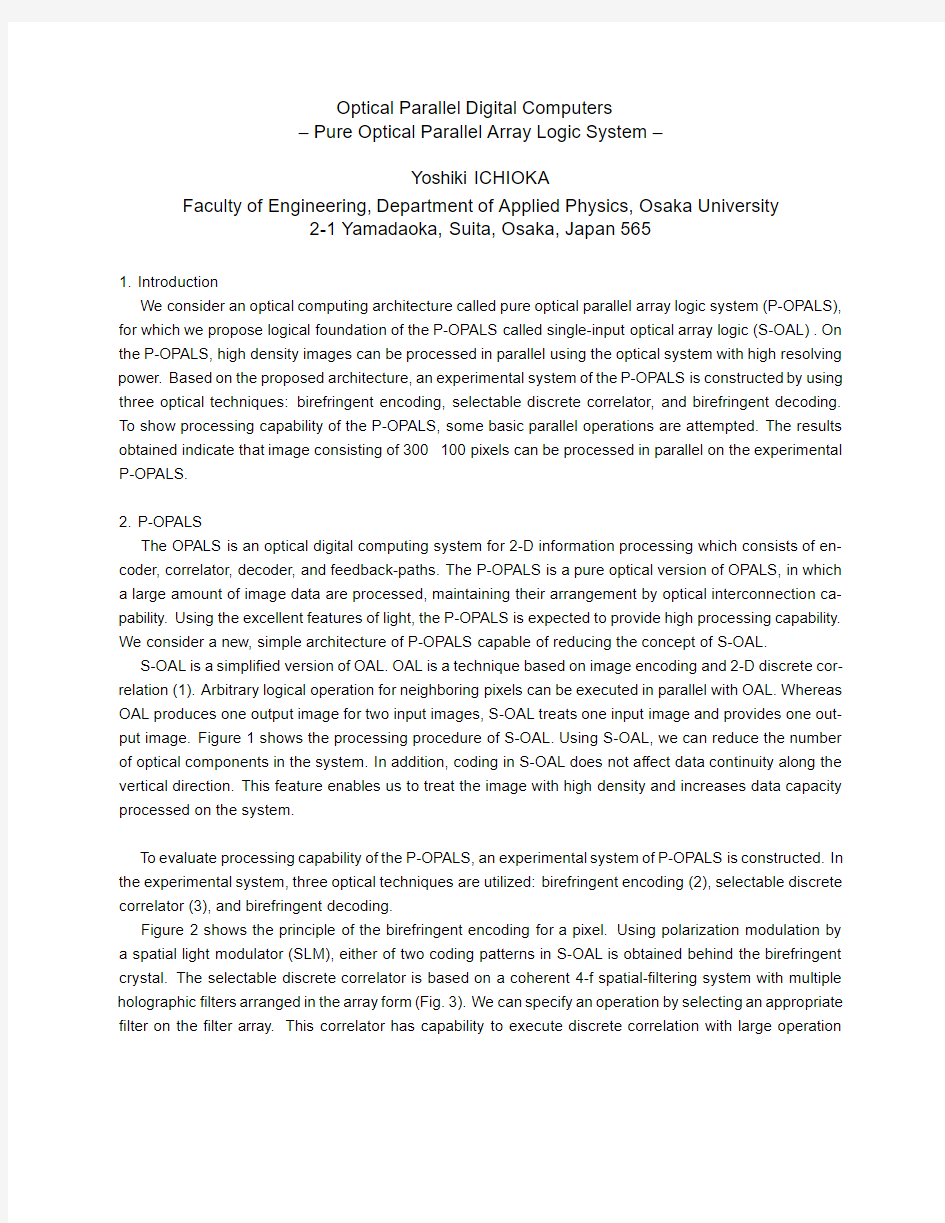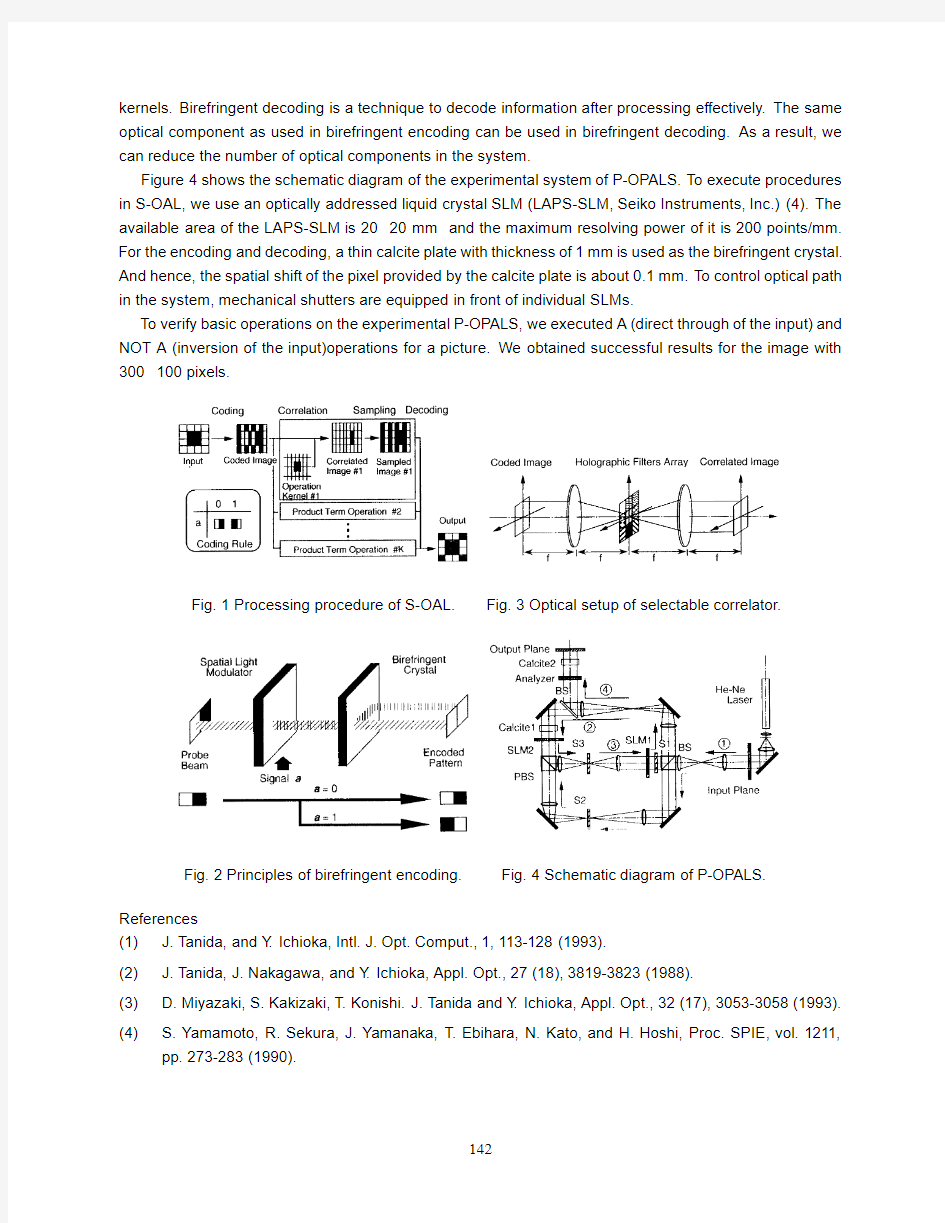Optical Parallel Digital Computers-- Pure Optical Parallel Array Logic System--


Optical Parallel Digital Computers
–Pure Optical Parallel Array Logic System–
Yoshiki ICHIOKA
Faculty of Engineering,Department of Applied Physics,Osaka University
2-1Yamadaoka,Suita,Osaka,Japan565
1.Introduction
We consider an optical computing architecture called pure optical parallel array logic system(P-OPALS), for which we propose logical foundation of the P-OPALS called single-input optical array logic(S-OAL).On the P-OPALS,high density images can be processed in parallel using the optical system with high resolving power.Based on the proposed architecture,an experimental system of the P-OPALS is constructed by using three optical techniques:birefringent encoding,selectable discrete correlator,and birefringent decoding. T o show processing capability of the P-OPALS,some basic parallel operations are attempted.The results obtained indicate that image consisting of300100pixels can be processed in parallel on the experimental P-OPALS.
2.P-OPALS
The OPALS is an optical digital computing system for2-D information processing which consists of en-coder,correlator,decoder,and feedback-paths.The P-OPALS is a pure optical version of OPALS,in which a large amount of image data are processed,maintaining their arrangement by optical interconnection https://www.360docs.net/doc/986192182.html,ing the excellent features of light,the P-OPALS is expected to provide high processing capability. We consider a new,simple architecture of P-OPALS capable of reducing the concept of S-OAL.
S-OAL is a simpli?ed version of OAL.OAL is a technique based on image encoding and2-D discrete cor-relation(1).Arbitrary logical operation for neighboring pixels can be executed in parallel with OAL.Whereas OAL produces one output image for two input images,S-OAL treats one input image and provides one out-put image.Figure1shows the processing procedure of https://www.360docs.net/doc/986192182.html,ing S-OAL,we can reduce the number of optical components in the system.In addition,coding in S-OAL does not affect data continuity along the vertical direction.This feature enables us to treat the image with high density and increases data capacity processed on the system.
T o evaluate processing capability of the P-OPALS,an experimental system of P-OPALS is constructed.In the experimental system,three optical techniques are utilized:birefringent encoding(2),selectable discrete correlator(3),and birefringent decoding.
Figure2shows the principle of the birefringent encoding for a https://www.360docs.net/doc/986192182.html,ing polarization modulation by a spatial light modulator(SLM),either of two coding patterns in S-OAL is obtained behind the birefringent crystal.The selectable discrete correlator is based on a coherent4-f spatial-?ltering system with multiple holographic?lters arranged in the array form(Fig.3).We can specify an operation by selecting an appropriate ?lter on the?lter array.This correlator has capability to execute discrete correlation with large operation
kernels.Birefringent decoding is a technique to decode information after processing effectively.The same optical component as used in birefringent encoding can be used in birefringent decoding.As a result,we can reduce the number of optical components in the system.
Figure4shows the schematic diagram of the experimental system of P-OPALS.T o execute procedures in S-OAL,we use an optically addressed liquid crystal SLM(LAPS-SLM,Seiko Instruments,Inc.)(4).The available area of the LAPS-SLM is2020mm and the maximum resolving power of it is200points/mm. For the encoding and decoding,a thin calcite plate with thickness of1mm is used as the birefringent crystal. And hence,the spatial shift of the pixel provided by the calcite plate is about0.1mm.T o control optical path in the system,mechanical shutters are equipped in front of individual SLMs.
T o verify basic operations on the experimental P-OPALS,we executed A(direct through of the input)and NOT A(inversion of the input)operations for a picture.We obtained successful results for the image with 300100pixels.
Fig.1Processing procedure of S-OAL.Fig.3Optical setup of selectable correlator.
Fig.2Principles of birefringent encoding.Fig.4Schematic diagram of P-OPALS.
References
(1)J.T anida,and Y.Ichioka,https://www.360docs.net/doc/986192182.html,put.,1,113-128(1993).
(2)J.T anida,J.Nakagawa,and Y.Ichioka,Appl.Opt.,27(18),3819-3823(1988).
(3) D.Miyazaki,S.Kakizaki,T.Konishi.J.T anida and Y.Ichioka,Appl.Opt.,32(17),3053-3058(1993).
(4)S.Yamamoto,R.Sekura,J.Yamanaka,T.Ebihara,N.Kato,and H.Hoshi,Proc.SPIE,vol.1211,
pp.273-283(1990).
142
